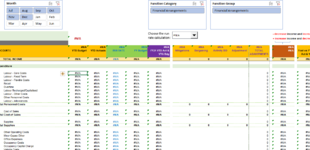Hello
My code opens (in sequence) all Excel files saved in a folder, refreshes them (their data models aggregate various tables of an SQL database) and closes them.
The code works well, does what it's supposed to do, but leaves the files with a #N/A error in all cells that use a CUBEVALUE formula. There is no pivot table involved.
I have attached an image showing the output.
To overcome the issue, I have to open all files, one by one. On opening, the data model finishes the refresh and returns real numbers.
Certainly, I cannot do that, else the presence of the code is not necessary.
The files are in an Automatic Calculation Mode.
I am inserting below the code I use.
For the life of me I cannot figure out why the files are not fully 100% refreshed when they are closed.
Thank you for your help
My code opens (in sequence) all Excel files saved in a folder, refreshes them (their data models aggregate various tables of an SQL database) and closes them.
The code works well, does what it's supposed to do, but leaves the files with a #N/A error in all cells that use a CUBEVALUE formula. There is no pivot table involved.
I have attached an image showing the output.
To overcome the issue, I have to open all files, one by one. On opening, the data model finishes the refresh and returns real numbers.
Certainly, I cannot do that, else the presence of the code is not necessary.
The files are in an Automatic Calculation Mode.
I am inserting below the code I use.
For the life of me I cannot figure out why the files are not fully 100% refreshed when they are closed.
Thank you for your help
VBA Code:
Option Explicit
Private Sub cmdOpenRefresh_Click()
Call loopAllSubFolderSelectStartDirectory
End Sub
Sub loopAllSubFolderSelectStartDirectory()
Dim fd As FileDialog: Set fd = Application.FileDialog(msoFileDialogFolderPicker)
With fd
.AllowMultiSelect = False
.InitialFileName = ThisWorkbook.Path & "\Monthly Rolling Forecasts"
.Title = "Open the folder containing the current forecast iteration"
.ButtonName = "Go!"
.InitialView = msoFileDialogViewDetails
End With
Dim bFolderWasChoosen As Boolean
bFolderWasChoosen = fd.Show
If bFolderWasChoosen Then
Call LoopAllSubFolders(fd.SelectedItems(1))
Else
Exit Sub
End If
Set fd = Nothing
End Sub
'List all files in subfolders
Sub LoopAllSubFolders(ByVal sFolderPath As String)
'adapted from:
'https://exceloffthegrid.com/vba-code-loop-files-folder-sub-folders/
Dim sFilename As String, sFullFilePath As String, lNumFolders As Long, arrFolders() As String
Dim i As Long
If VBA.Right(sFolderPath, 1) <> "\" Then sFolderPath = sFolderPath & "\"
sFilename = VBA.Dir(sFolderPath & "\*.*", vbDirectory)
Do
If VBA.Left(sFilename, 1) <> "." Then
sFullFilePath = sFolderPath & sFilename
If (GetAttr(sFullFilePath) And vbDirectory) = vbDirectory Then
ReDim Preserve arrFolders(0 To lNumFolders) As String
arrFolders(lNumFolders) = sFullFilePath
lNumFolders = lNumFolders + 1
Else
'Insert the actions to be performed on each file
'This example will print the full file path to the immediate window
Dim sFilePath As String: sFilePath = CheckWkbOpen(sFolderPath & sFilename)
Dim wkb As Workbook
If sFilePath = True Then
Exit Sub
Else
Set wkb = Workbooks.Open(filename:=sFolderPath & sFilename)
End If
wkb.Model.Refresh
With Application
.CalculateUntilAsyncQueriesDone
.Calculation = xlCalculationAutomatic
End With
wkb.Close SaveChanges:=True
Set wkb = Nothing
End If
End If
sFilename = VBA.Dir()
Loop Until sFilename = ""
For i = 0 To lNumFolders - 1
LoopAllSubFolders arrFolders(i)
Next i
End Sub
Private Function CheckWkbOpen(sFilename As String) As Boolean
'adapted from:
'https://exceloffthegrid.com/vba-code-loop-files-folder-sub-folders/
Dim lFileNo As Long, lErrorNo As Long
On Error Resume Next
lFileNo = VBA.FreeFile()
Open sFilename For Input Lock Read As #lFileNo
Close lFileNo
lErrorNo = Err
On Error GoTo 0
Select Case lErrorNo
Case 0
CheckWkbOpen = False
Case 70
CheckWkbOpen = True
Case Else
Error lErrorNo
End Select
End Function





